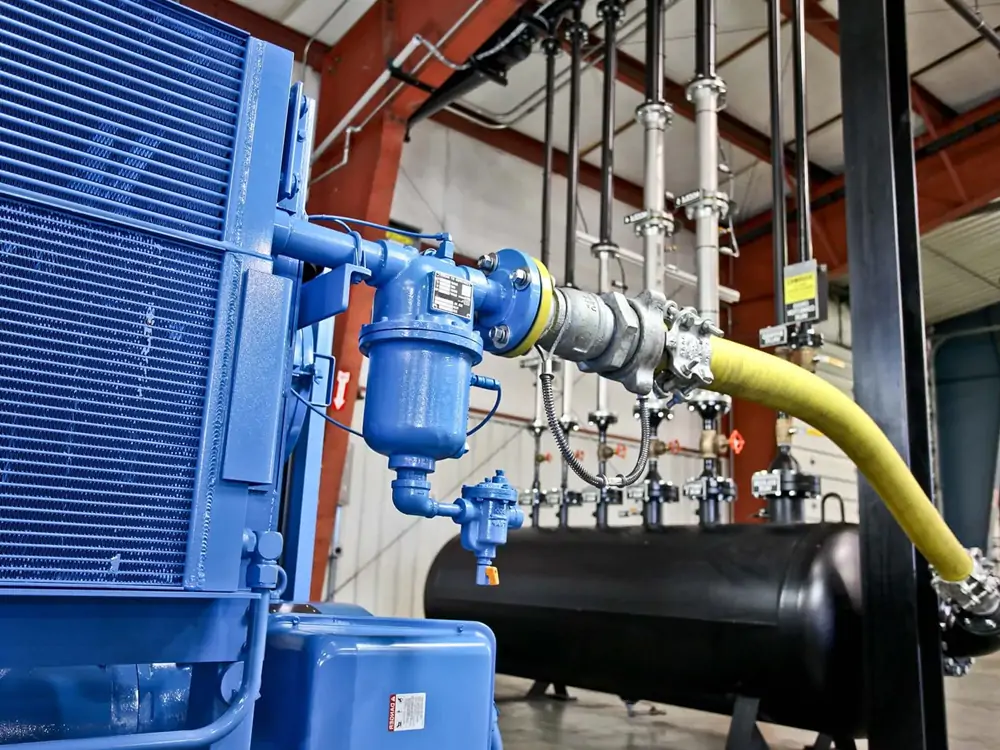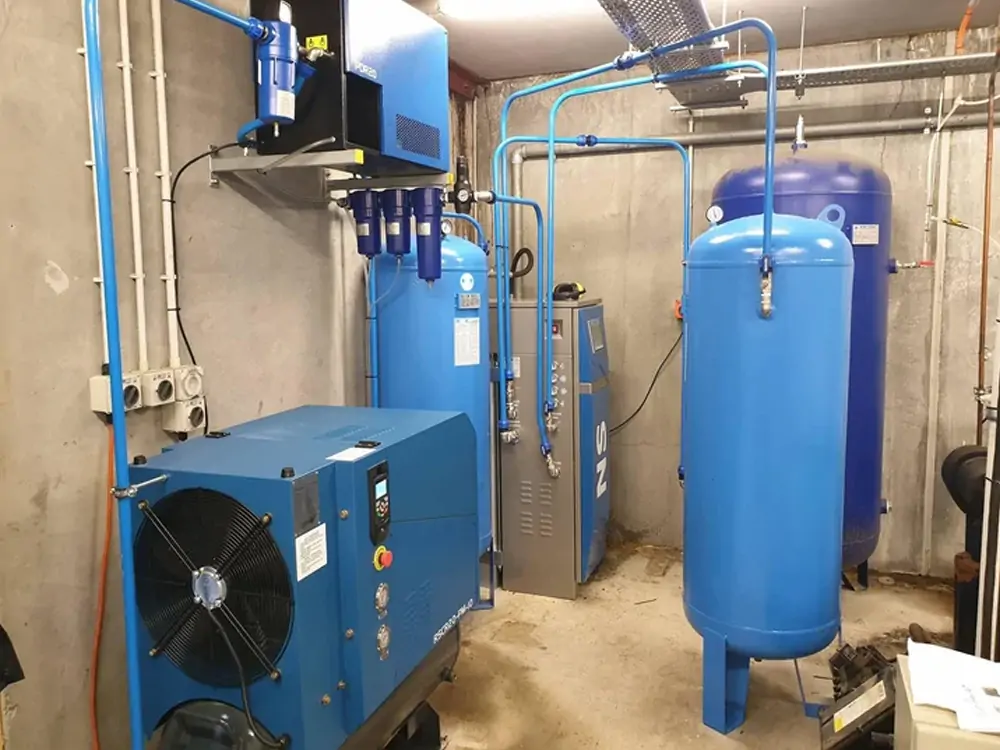When discussing industrial manufacturing or other applications requiring compressed air, air quality is an often overlooked but crucial element. We often focus on ensuring our compressed air systems provide enough pressure to drive equipment. But we rarely consider the humidity and purity of the air. This is where compressed air dryers become essential.
This article explores why compressed air dryers are indispensable equipment in many situations. We’ll look at when you might need a compressed air dryer. Whether you are an industrial manufacturer or use compressed air daily, this article will help you better understand why you should consider investing in a quality compressed air dryer. Let’s explore how this seemingly small but important device can have a profound impact on a variety of applications.
Where Does The Water in Compressed Air Come From?
Die Feuchtigkeit in der Druckluft stammt hauptsächlich aus der Atmosphäre. Dies ist der natürlichen Luft eigen. Unabhängig von der Jahreszeit, the atmosphere has a certain relative humidity. Zusätzlich, nach Kompression oder Abkühlung, the water vapor in the air will become liquid. Dies beeinträchtigt die Qualität der Druckluft.
In industrial air compressor applications, many users are very sensitive to moisture. Since we can’t eliminate the water before the air compressor, it must remove moisture in the compressed air treatment system.
Vor dem Betreten des Luftkompressors, Die Feuchtigkeit in der Luft besteht hauptsächlich aus Wasserdampf. Und es ist ungesättigt. Wie im Blatt gezeigt 1, die relative Luftfeuchtigkeit ist 69%, und die Temperatur beträgt 20°C. Nach der Komprimierung (7 Bar), Der Wasserdampf in der Druckluft wird durch die Kühlung des hinteren Kühlers des Luftkompressors gesättigt. Und 42% Es fallen 100 % flüssiges Wasser aus. A gas-water separator and storage tank can remove this liquid water. Der Rest 58% of water is in the compressed air as water vapor.
Wenn kein Luftkompressor-Trockner vorhanden ist, the direct use of compressed air will be bad for production. Deshalb, refrigerated and desiccant air dryers have become the preferred air treatment equipment.
Es gibt drei allgemeine Anforderungen an den Wassergehalt von Druckluft.
① The air compressor discharges compressed air. Wenn es einen Kühler gibt + Luftbehälter, then it can lower the temperature by 3 Zu 10 ℃. This can meet customers with low-quality air, wie Bohrinseln, Luftkanonen, usw.
② But most industrial enterprises generally have such requirement :10℃>Drucktaupunkt>0℃. This requires using an air compressor refrigerated dryer to remove the water vapor.
③ If the need for dew point ≤ 0 ℃, choosing a desiccant air compressor air dryer is necessary. The common dew point requirements for adsorption compressed air dryers are -20℃, 40℃, and 70℃.
What Are The Specific Problems That Arise?
Der Luftkompressor gibt die Druckluft ab, aber es ist nicht sauber. There are many contaminants, wie zum Beispiel Feuchtigkeit, Staubpartikel, Öl, usw. They will enter the production process if they are not purified and dry. Darüber hinaus, Viele Schraubenkompressoren sind Ölkompressoren. This leads to many problems.
Production Capacity Decline
If there is no air dryer compressed air, Feuchtigkeit, and oil will clog and rust pneumatic equipment and tools. Dies führt zu einem langsamen Betrieb. Neben, Verstopfte Leitungen und Teile führen zu einem niedrigeren Druck. Und die Werkzeuge werden an Effizienz verlieren. In a long time, die Ausrüstung wird kaputt gehen. In schweren Fällen, Dies kann zu Produktionsausfällen führen.
Increase Product Defect Rate
Ein hoher Wassergehalt in der Druckluft führt zu einer erhöhten Produktausfallrate. Zum Beispiel, spray painting and electronic product processing. In Laser- oder Plasmaschneidmaschinen, Feuchtigkeit verunreinigt die Linsen unserer Schneidköpfe. So, it will directly affect the cutting efficiency.
Zusätzlich, various influence exists in the food industry. Bei der Verpackung und dem Transport von Lebensmitteln spielt häufig Druckluft eine Rolle. Auch, Druckluft kommt häufig mit dem Produkt in Berührung.
Wenn kein Luftkompressor-Lufttrockner vorhanden ist, then much moisture or oil can damage our food. Vor allem in der Trockenfutterindustrie, Es gelten strengere Anforderungen an die Luftfeuchtigkeit. ISO-Normen sehen unterschiedliche Klassen für die Druckluftqualität in der Lebensmittelindustrie vor. Different levels have different contents of solids, Wasser, und Öl.
Air Aerodynamic Loss
Wasser in der Druckluft führt zur Korrosion der Rohre. Dies führt zu Rohrverstopfungen. Darüber hinaus, mixing water, Öl, and dust can exacerbate blockages. Neben, in kalten Regionen, Durch das Einfrieren von Feuchtigkeit können Rohre einfrieren. Dann sinkt der Druck und die Druckdifferenz wird groß. Letztlich, it will affect the safety of production. Zusätzlich, it will lead to air leakage from the pipeline in serious cases.
Zur Wasserentfernung sind daher ein gekühlter Drucklufttrockner und ein Adsorptionsluftkompressortrockner erforderlich.
Increase Production And Maintenance Costs
Feuchtigkeit und Öl schädigen unsere pneumatischen Komponenten direkt. Neben, they will also corrode our equipment. Dann müssen wir die Ersatzteile durch neue ersetzen. Dies erhöht sowohl die Wartungskosten als auch die Produktionszeitkosten.
To improve compressed air quality, you must install precision filters to remove oil and water. Dann, install an air compressor air dryer to remove the water deeply. Dadurch wird der Taupunkt auf die Anwendungsanforderungen gebracht.

What Can Compressed Air Dryers Bring You
A compressor air dryer is a device used to process compressed air. It improves compressed air quality by removing moisture and other impurities from the air. Below are some of the main functions the air compressor dryer can perform.
Dehumidification
Compressed air often contains significant amounts of moisture, harming many applications. Compressed air dryers remove moisture from the air through technologies such as cooling, Adsorption, or membrane separation. This prevents moisture from corroding, icing, or other problems with equipment and processes.
Purify
The air may contain particulate matter, grease, bacteria, und andere Verunreinigungen. These impurities can cause problems in some sensitive applications. Air dryer compressed air can filter these impurities and provide cleaner and purer compressed air.
Improve System Efficiency
Dehumidification and purification of compressed air can improve the efficiency of compressors and pneumatic equipment. Dry air transports energy more efficiently, reduces corrosion on pipes and equipment, and reduces maintenance costs.
Extend Equipment Life
Compressed air dryers can extend the life of compressors, valves, and other critical components by reducing damage to equipment from moisture and impurities, downtime, and repair costs.
Ensure Product Quality
In some manufacturing processes, compressed air is used to carry raw materials or participate directly in the manufacture of products. If the air contains moisture or contaminants, this may adversely affect product quality. Air dryer compressed air ensures that products are free from contamination and meet quality standards.
When Do You Need A Compressed Air Dryer
There are many situations where you might need an air compressor dryer. It depends on your application and environment. Below are some common situations.
Pneumatic Equipment
If you work with pneumatic tools, control systems, or machinery, dry compressed air is essential to their proper operation. Moisture can cause stuck valves, leaky cylinders, or tool failure.
Precision Manufacturing
In precision manufacturing, such as electronics, Halbleiter, or optical manufacturing, tiny water droplets or particles in the air can cause damage to products. The air compressor dryer ensures the required air quality during production.
Food And Pharmaceutical Industry
In food and pharmaceutical production, hygiene standards are very strict. Moisture and contaminants can pose a threat to product safety and quality. Dry compressed air helps avoid these problems.
Cooling And Freezing Applications
In cooling and freezing systems, dehumidified compressed air helps prevent freezing and frost and maintains stable system operation.
Painting And Coating
If you use compressed air in automotive painting, woodworking, or other coating applications, Feuchtigkeit, and oils can adversely affect the quality of the coating. A compressed air dryer ensures uniform coating and good quality.
Gas Production
Certain gas production processes require extremely high-purity gases, and dehumidification and purification of compressed air are key steps in producing high-purity gases.
Avoid Pipeline Corrosion
Moisture and contaminants can trigger corrosion in pipes and vessels. This may cause leakage or damage to the equipment. Compressor air dryers protect equipment and infrastructure from such hazards.
Energy Saving
Dehumidified compressed air requires less energy to transport. Drying air, therefore, reduces energy costs and increases system efficiency.

Conclusion
In diesem Artikel, we dig into the importance of air compressor dryers and when to consider using them. Whether it is industrial manufacturing, precision manufacturing, food processing, pneumatic equipment, or other applications, compressed air quality is one of the key factors in ensuring system efficiency and product quality.
A compressed air dryer can be a seemingly small and easily overlooked device. But it is critical to many industries and applications. Ensuring your compressed air is of the right quality can increase productivity, reduce maintenance costs, and ensure product quality. So, whether you need a compressed air dryer depends on your needs. But considering them is often a smart choice that can provide lasting benefits to your workflow and business.
